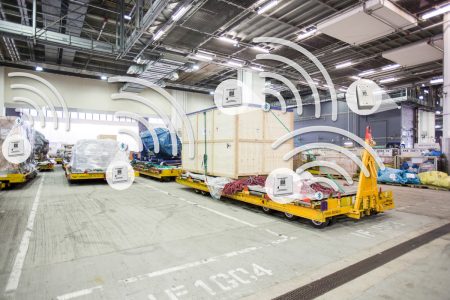Cargo Clan spoke with GM Cargo Service Delivery Frosti Lau and Calvin Hui, eCargo and Digital Enablement Manager, to discuss how Cathay Pacific is starting to deploy new technology that will add transparency, traceability, accuracy and efficiency to the supply chain process – something that customers are keen to see.
They have been working on two projects, both featuring blockchain and Bluetooth, which will act as technological pathfinders for future developments, including next generation track and trace.
The first is about the location of the ULDs that Cathay Pacific uses and lends out to agents to build up their shipments.
‘Most of the cargo supplied to us in Hong Kong is pre-packed,’ says Frosti. ‘That means we release empty ULDs to cargo agents and they build up the cargo at their warehouse and then submit the cargo as a pre-packed unit to us. So you can imagine this loan process requires a lot of ULD movements, and a lot of ULDs are with agents at any given time.’
Additionally, as units are released to agents, the unique registration numbers for each are entered manually. If this information is not entered correctly, the ULD in question effectively falls out of the system.
Under IATA guidelines, ULD ‘owners’ are entitled to charge ‘demurrage’ fees for units held longer than five days. However, Calvin stresses that the project is not designed as a revenue raiser, but to simply track the units so that the airline’s supplier, Unilode Aviation Solutions, which manages Cathay Pacific’s ULDs, has more units available for use on the Cathay Pacific network.
Calvin says: ‘We have built a database with a smart contract distribution ledger [blockchain] that enables us to clearly define the custody of each unit, which time stamps the ownership.’
It means that rather than sitting unloved at the back of an agent’s warehouse while new ones are delivered, the ULDs will be where they are really needed. Calvin adds: ‘During the boom in business last year, we noticed that there was an increased number of “idling” ULDs that we couldn’t use immediately, when we would rather have had them available for shipments.’
So how does it work? In the early stages of the trial, each ULD had a QR code fitted to it, and Cathay Pacific’s IT team devised a simple app that captures the ULD’s unique number and the agent that it is released to. It creates a timestamp and a record on the uneditable ledger, as well as a count down to the point that demurrage could theoretically be collected. The app was also released to agents, so they can scan the built-up ULD when it leaves their warehouse to effectively end ‘the countdown’.
So far, only blockchain has been used, but real value comes once you add Bluetooth to the equation. Unlike QR codes, which are static, Bluetooth is dynamic and offers a greater array of options and measurements by linking them to sensors.
Cathay Pacific has just conducted a ‘proof of technology’ trial using Bluetooth low energy beacons and readers in its cargo terminal and checked how they worked with Google Maps. This was an important test, because transmission can be difficult in multi-storey, concrete surroundings, filled with electrical equipment. The trial, using equipment from OnAsset Intelligence, was a success, and offers huge potential for future innovation.
In the first instance, the QR codes on ULDs could be updated with Bluetooth beacons, which automate the ULD blockchain ledger as units are driven out of the Cathay Cargo Terminal. But that’s just at pallet level. By using these devices in ULDs or in individual boxes within a built-up shipment, these can become the building blocks for that data-rich, transparent end-to-end shipment tracking that the market is interested in.
Frosti says: ‘As part of our digital strategy we want to extend blockchain to underpin next generation track and trace using the “internet of things”. Tracking ULDs is one thing but it is the ability to offer multi-dimensional shipment status at piece level, which is our long-term ambition.’
That means recording items such as time, location, duration, temperature and so on, which combined with blockchain’s immutable ledger and shipment documentation, give those who need it visibility of the whole journey. This aligns with IATA’s Piece Level Tracking Taskforce and OneRecord.
Calvin says: ‘Let's say a shipper wants to get life-saving vaccines to Hong Kong. How does the consignee know that they are receiving the same product that was dispatched? With blockchain they have that reassurance because the ledger is immutable; we can keep track of all stages of the journey. Additionally, the authenticity of the shipment can be assured, the temperature can be checked against requirements, and all these items are recorded in the blockchain.
While the proof of concept may have worked, there is still a long way to go before this rolls out in Hong Kong, let alone across the network, but keep an eye out for local trials rather than a complete roll-out – this is an ‘agile’ project.
And there is one more part of the journey to cover; on board the aircraft. Bluetooth or not, if the information these Bluetooth devices capture cannot be transmitted, then the flight is still dark in terms of being able to react to temperature excursions, for example. Calvin says: ‘Ideally we want people to react immediately, but an off-the-shelf product isn’t going to solve the problem of air to ground communication. All we know is that when the plane has landed and we find that there have been temperature excursions, it’s too late.’
‘But if we received information from the aircraft, we could implement service recovery action immediately, or notify the shipper to get them to prepare a new consignment if it’s too much of an excursion, or make sure there is dry ice on hand when the aircraft lands to save the situation.’
There are issues to tackle, but the message is the journey to achieving piece-level, next-generation track and trace has begun.

